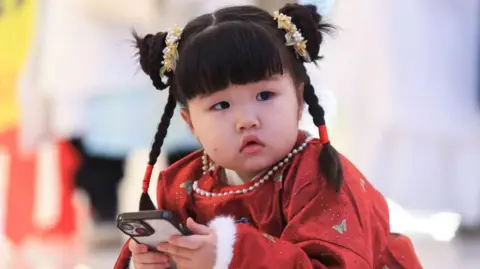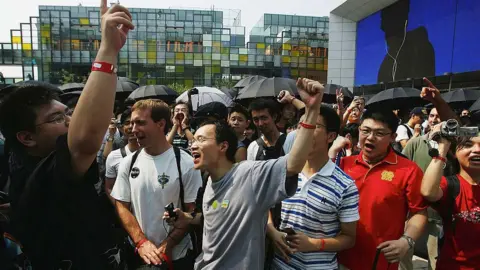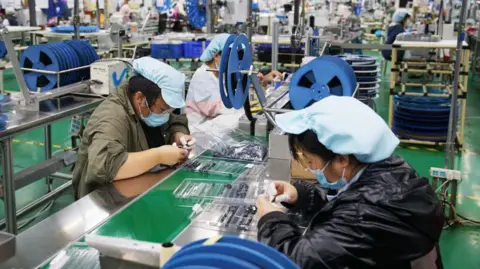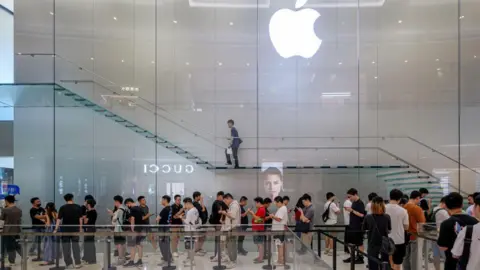Business reporter
 Getty Images
Getty ImagesEvery iPhone comes with a label which tells you it was designed in California.
While the sleek rectangle that runs many of our lives is indeed designed in the United States, it is likely to have come to life thousands of miles away in China: the country hit hardest by US President Donald Trump’s tariffs, now rising to 245% on some Chinese imports.
Apple sells more than 220 million iPhones a year and by most estimates, nine in 10 are made in China. From the glossy screens to the battery packs, many of the components in an Apple product are made, sourced and assembled into iPhones, iPads or Macbooks in China. Most are shipped to the US, Apple’s largest market.
Luckily for the firm, Trump suddenly exempted smartphones, computers and some other electronic devices from his tariffs last week.
But the comfort is short-lived.
The president has since suggested that more tariffs are coming: “NOBODY is getting ‘off the hook'”, he wrote on Truth Social, as his administration investigated “semiconductors and the WHOLE ELECTRONICS SUPPLY CHAIN”.
The global supply chain that Apple has touted as a strength is now a vulnerability.
The US and China, the world’s two biggest economies, are interdependent and Trump’s staggering tariffs have upended that relationship overnight, leading to an inevitable question: who is the more dependent of the two?
How a lifeline became a threat
China has hugely benefited from hosting assembly lines for one of the world’s most valuable companies. It was a calling card to the West for quality manufacturing and has helped spur local innovation.
Apple entered China in the 1990s to sell computers through third-party suppliers.
Around 1997, when it was on the verge of bankruptcy as it struggled to compete with rivals, Apple found a lifeline in China. A young Chinese economy was opening up to foreign companies to boost manufacturing and create more jobs.
 Getty Images
Getty ImagesIt wasn’t until 2001 though that Apple officially arrived in China, through a Shanghai-based trading company, and started making products in the country. It partnered with Foxconn, a Taiwanese electronic manufacturer operating in China, to make iPods, then iMacs and subsequently iPhones.
As Beijing began trading with the world – encouraged by the US no less – Apple grew its footprint in what was becoming the world’s factory.
Back then, China was not primed to make the iPhone. But Apple chose its own crop of suppliers and helped them grow into “manufacturing superstars”, according to supply chain expert Lin Xueping.
He cites the example of Beijing Jingdiao, now a leading manufacturer of high-speed precision machinery, which is used to make advanced components efficiently. The company, which used to cut acrylic, was not considered a machine tool-maker – but it eventually developed machinery to cut glass and became “the star of Apple’s mobile phone surface processing,” Mr Lin says.
Apple opened its first store in the country in Beijing in 2008, the year the city hosted the Olympics and China’s relationship with the West was at an all-time high. This soon snowballed to 50 stores, with customers queuing out of the door.
As Apple’s profit margins grew, so did its assembly lines in China, with Foxconn operating the world’s largest iPhone factory in Zhengzhou, which has since been termed “iPhone City”.
For a fast-growing China, Apple became a symbol of advanced Western tech – simple yet original and slick.
Today, most of Apple’s prized iPhones are manufactured by Foxconn. The advanced chips that power them are made in Taiwan, by the world’s largest chip manufacturer, TSMC. The manufacturing also requires rare earth elements which are used in audio applications and cameras.
Some 150 of Apple’s top 187 suppliers in 2024 had factories in China, according to an analysis by Nikkei Asia.
“There’s no supply chain in the world that’s more critical to us than China,” Apple’s CEO Tim Cook said in an interview last year.
 Getty Images
Getty ImagesThe tariff threat – fantasy or ambition?
In Trump’s first term, Apple secured exemptions on the tariffs he imposed on China.
But this time, the Trump administration has made an example of Apple before it reversed tariffs on some electronics. It believes the threat of steep taxes will encourage businesses to make products in America instead.
“The army of millions and millions of human beings screwing in little screws to make iPhones – that kind of thing is going to come to America,” Commerce Secretary Howard Lutnick said in an interview earlier this month.
White House Press Secretary Karoline Leavitt reiterated that last week: “President Trump has made it clear America cannot rely on China to manufacture critical technologies such as semiconductors, chips, smartphones and laptops.”
She added: “At the direction of the president, these companies are hustling to onshore their manufacturing in the United States as soon as possible.”
But many are sceptical of that.
The thought that Apple could move its assembly operation to the US is “pure fantasy”, according to Eli Friedman, who formerly sat on the firm’s academic advisory board.
Mr Friedman said the company has been talking about diversifying its supply chain away from China since 2013, when he joined the board – but the US was never an option.
He added that Apple didn’t make much progress over the next decade but “really made an effort” after the pandemic, when China’s tightly-controlled Covid lockdowns hurt manufacturing output.
“The most important new locations for assembly have been Vietnam and India. But of course the majority of Apple assembly still takes place [in China].”
Apple did not respond to the BBC’s questions but its website says its supply chain spans “thousands of businesses and more than 50 countries”.
 Getty Images
Getty ImagesChallenges ahead
Any change to Apple’s current supply chain status quo would be a huge blow for China, which is trying to kickstart growth post-pandemic.
Many of the reasons that the country wanted to be a manufacturing hub for Western companies in the early 2000s ring true today – it creates hundreds of thousands of jobs, and gives the country a crucial edge in global trade.
“Apple sits at the intersection of US-China tensions, and tariffs highlight the cost of that exposure,” says Jigar Dixit, a supply chain and operations consultant.
It might explain why China has not bowed to Trump’s threats, retaliating instead with 125% levies on US imports. China has also imposed export controls on a range of critical rare earth minerals and magnets it has in stores, dealing a blow to the US.
There is no doubt the US tariffs still being levied on other Chinese sectors will hurt, though.
And it’s not just Beijing facing higher tariffs – Trump has made it clear he will target countries that are part of the Chinese supply chain. For instance Vietnam, where Apple has moved AirPods production, was facing 46% tariffs before Trump hit pause for 90 days, so moving production elsewhere in Asia is not an easy way out.
“All conceivable places for the huge Foxconn assembly sites with tens or hundreds of thousands of workers are in Asia, and all of these countries are facing higher tariffs,” Mr Friedman said.
So what does Apple do now?
 Getty Images
Getty ImagesThe company is fighting off stiff competition from Chinese firms as the government pushes for advanced tech manufacturing in a race with the US.
Now that “Apple has cultivated China’s electronic manufacturing capabilities, Huawei, Xiaomi, Oppo and others can reuse Apple’s mature supply chain,” according to Mr Lin.
Last year, Apple lost its place as China’s biggest smartphone seller to Huawei and Vivo. Chinese people are not spending enough because of a sluggish economy and with ChatGPT banned in China, Apple is also struggling to retain an edge among buyers seeking AI-powered phones. It even offered rare discounts on iPhones in January to boost sales.
And while operating under President Xi Jinping’s increasingly close grip, Apple has had to limit the use of Bluetooth and Airdrop on its devices as the Chinese Communist Party sought to censor political messages that people were sharing. It weathered a crackdown on the tech industry that even touched Alibaba founder and multi-billionaire Jack Ma.
Apple has announced a $500bn (£378bn) investment in the US, though that may not be enough to appease the Trump administration for long.
Given the several U-turns and the uncertainty around Trump’s tariffs, more unexpected levies are expected – which could again leave the company with little manoeuvring room and even less time.
Mr Dixit says smartphone tariffs will not cripple Apple should they rear their head again, but regardless will add “pressure – both operationally and politically” to a supply chain that cannot be unwound quickly.
“Clearly the severity of the immediate crisis has been lessened,” Mr Friedman says, referring to last week’s exemption for smartphones.
“But I really don’t think this means Apple can relax.”
Additional reporting by Fan Wang









